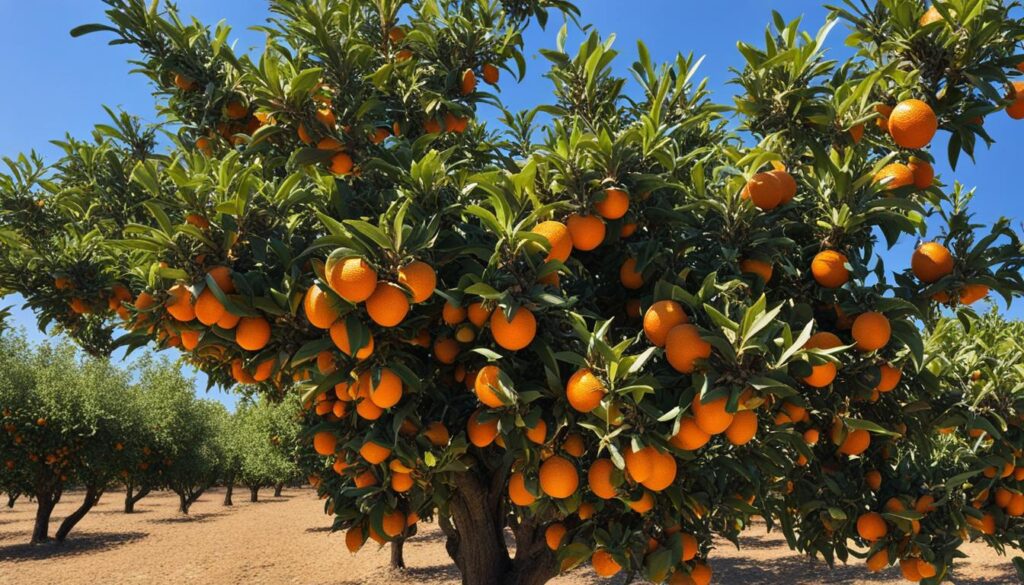When you think of orange trees, you may not immediately picture them with thorns. However, it is a lesser-known fact that most citrus fruit trees, including orange trees, do have thorns. These thorny protrusions serve an important purpose in protecting the tree and its fruit from predators and potential harm.
Thorns on citrus trees develop at the nodes and can be found on new grafts and fruiting wood. They act as a natural defense mechanism against hungry animals that may want to feed on the leaves and fruit. By having thorns, orange trees are better equipped to ward off potential threats.
While many juvenile citrus trees have thorns, mature specimens often do not. As citrus trees grow and develop, they tend to outgrow their thorns. That said, there are still several orange varieties that have larger thorns, which are generally bitter and less commonly consumed.
For those who prefer a thorn-less experience, there are thorn-less and hybrid varieties available. However, it is important to note that these varieties may lack some of the flavor and productivity of their thorny counterparts.
Whether orange trees have thorns or not, they continue to be a beloved fruit tree worldwide, cherished for their vibrant citrus fruit, refreshing flavor, and nutritional value. Explore the world of orange trees and discover the variety of thorn-less and thorny options that nature has to offer.
Why Do Orange Trees Have Thorns?
The presence of thorns on citrus trees, including orange trees, serves a crucial purpose: protection. Just like animals with prickly hides, such as hedgehogs and porcupines, citrus trees have evolved to use thorns as a defense mechanism against potential predators.
Thorns act as natural deterrents, preventing hungry animals from nibbling on the delicate foliage and fruit of the tree. This protection is especially important during the early stages of growth when the vegetation is most vulnerable.
However, it’s worth noting that as citrus trees mature, they often outgrow their thorns. So while young citrus trees may have a more thorny appearance, don’t be discouraged as the thorns are likely to diminish as the tree develops.
While thorns provide essential protection for the tree, they can pose challenges for citrus cultivators. Harvesting the fruit becomes more difficult due to the thorny branches, requiring extra caution and protective gear.
To address this issue, many citrus growers practice pruning to remove the thorns from the branches containing the fruit. This common technique allows for easier harvest while still maintaining the protective benefits of the thorns on other parts of the tree.
Another cultivation technique that mitigates the impact of thorns is grafting. During the grafting process, growers often remove thorns from the rootstock to ensure that the resulting tree is less thorny. This not only makes it easier to handle and harvest the fruit but also improves the overall aesthetic appeal of the tree.
Managing Thorns on Orange Trees
While the presence of thorny growth on citrus trees, including orange trees, is a natural occurrence, it is essential to understand how to manage it effectively. Thorniness is often observed on the strong and vigorous shoots of citrus trees, but it is crucial to differentiate between thorny growth originating from above the graft union and growth from below the graft union, which comes from the rootstock.
Thorny growth above the graft union is considered desirable and is an inherent characteristic of the cultivated variety. However, growth arising from the rootstock below the graft union can lead to undesirable thorny growth. To prevent this, it is important to promptly remove any sprouts originating from the rootstock.
Pruning thorns on citrus trees is a common practice for safety purposes and does not cause any harm to the tree. Regular pruning helps maintain a manageable tree structure and ensures the safety of both the tree and those tending to it. By selectively removing thorns, you can eliminate any potential hazards while still enjoying the beauty and benefits of your orange tree.
Remember, managing thorns on orange trees is not about eradicating them entirely but rather striking a balance between safety and the tree’s natural growth. With the proper care and attention, you can enjoy a thorn-less experience while savoring the delectable fruits of your orange tree.
– Do Orange Trees Keep Their Leaves All Year Round?
Yes, orange trees are deciduous trees, but they do not lose all of their leaves at the same time. Instead, they shed their old leaves and grow new ones throughout the year. This is one of the deciduous tree characteristics that allows them to adapt to different climates and seasons.










